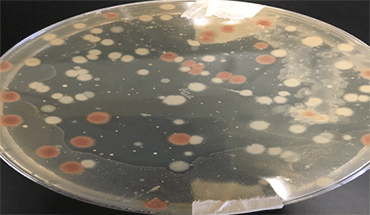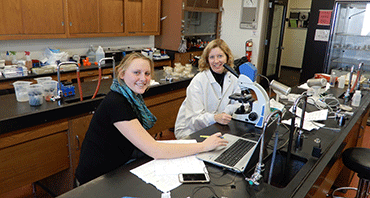Which bacteria hang out in belly buttons? Here’s a who’s who
As people age, they have more types — but fewer bugs overall

What’s in your belly button? Not just lint. A teen did some science to find out what microbes were living in people’s navels.
paylessimages/istockphoto
PITTSBURGH, Pa. — For Kathleen Schmidt, 18, the biggest challenge in her research was finding people willing to swab their belly buttons. Her tiny town of Ashley, N.D., has only 600 residents — and most weren’t too willing to bare their bellies for science. “I got a lot of no’s,” the teen recalls. “Even my sister wouldn’t let me swab hers.” But with a lot of begging, the senior at Ashley Public School got her volunteers. She used swabs of their belly buttons to create a who’s who of the microbes living on — and in — our navels.
Belly buttons — or navels — are leftovers. They mark the spot where the umbilical cord once linked mother and child. As the baby was developing in the womb, the umbilical cord served as the pipeline delivering food and oxygen. It also carried away wastes.
After birth, the umbilical cord gets cut, leaving behind a scar affectionately known as the belly button. Some people have navels that are little hollows, sometimes called “innies.” Others have belly buttons that stick out, called “outies.” All are good spots for bacteria to hang out. “Because it’s warm and moist,” Kathleen notes, “a belly button is the perfect place for bacteria to grow, especially innies.”
The microbes living in navels are part of their hosts’ microbiome — the community of microscopic organisms such as bacteria, viruses and fungi that live on and in all animals and plants. Some types of microbes can cause illness. Many can help protect the body from other, nasty bacteria.
“I love people and I also love bacteria a lot,” Kathleen says, and “I wanted to do a project where I could combine them both.” While she was reading scientific papers, she came across a study by Robert Dunn. He’s an ecologist at North Carolina State University in Raleigh. And in 2012, his team published a paper in the journal PLOS ONE. They, too, had been studying the microbes that lived in belly buttons. “It inspired me, the stuff he found,” Kathleen explains. “I wanted to find some of this stuff!”

After asking around her town for three weeks, the teen came up with 40 volunteers. There was an even mix of males and females. Kathleen also selected her navels carefully, dividing them into four age groups, with 10 people in each. The recruits swabbed their belly buttons. Kathleen then rubbed the swabs on agar plates — plastic disks filled with a gel that bacteria like to eat.
The teen kept her plates in an incubator for three days at roughly body temperature: 37.5° Celsius (or 99.5° Fahrenheit). Then she drove her plates several hours to the University of Mary in Bismarck, N.D. There, with the help of biologist Christine Fleischacker, Kathleen used a microscope to identify and count the microbes growing on her plates.
“I found a lot of bacteria,” she says. “Most of it was Bacillus [a genus of bacteria] which is very good. If you want a bacterium in your bellybutton — and you do — it’s Bacillus. It…fights off bad bacteria.” Kathleen also found bacterial from other genuses, which are groups of closely related species. These included Staphylococcus (or staph). This germ can cause disease if it gets into the wrong places. Many of the bacteria she found in her navel samples were similar to bacteria that Dunn and his group had reported before.
Who has which belly button bugs?
Most of the time, there was no difference between males and females, the teen found. The exception? Women ages 14 to 29 harbored fewer bacteria than did men in their age group. And for good reason. “When I asked how many of [the volunteers] cleaned their bellybuttons, all 5 females said they did,” Kathleen recalls. “Only two of the males said they cleaned on the daily.”
The biggest differences were not a matter of whether the hosts were clean or dirty, but instead their age. Adult volunteers had many more types of bacteria in their navels. But while the communities inhabiting adult navels were more diverse, children had belly buttons with many more individual bacteria.

And what about the outies and innies? “Outies primarily only have Bacillus and staph,” she says. Innies tended to have more diverse mixes of bacteria. One even harbored a fungus.
Kathleen shared her navel results here, this week, at the Intel International Science and Engineering Fair (ISEF). Created by Society for Science & the Public, or SSP, and sponsored by Intel, the competition this year brought together students from 81 countries. The nearly 1,800 competitors showed off the science-fair projects that won them a spot as a finalist at this year’s event. (SSP also publishes Science News for Students and this blog).
It may seem like silly science, but in fact it’s important to figure out which bacteria live on our skin. “People should be aware of what’s on their body, how it affects them and the world,” Kathleen says.
“This is amazing,” Dunn says, after learning of the work he inspired in Kathleen. “I love that she thought to focus in on things we missed.”
The teen’s project has only made her love of microbes stronger. “This is what I’m going to do for the rest of my life,” she says. “I love it so much.” She’s already gotten a job for the fall, when she starts college at North Dakota State University in Fargo. She’ll be working in a microbiology lab, of course.
Follow Eureka! Lab on Twitter







